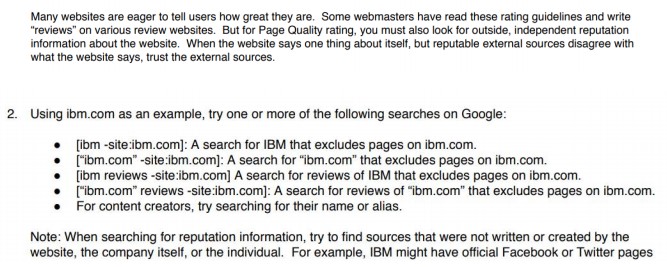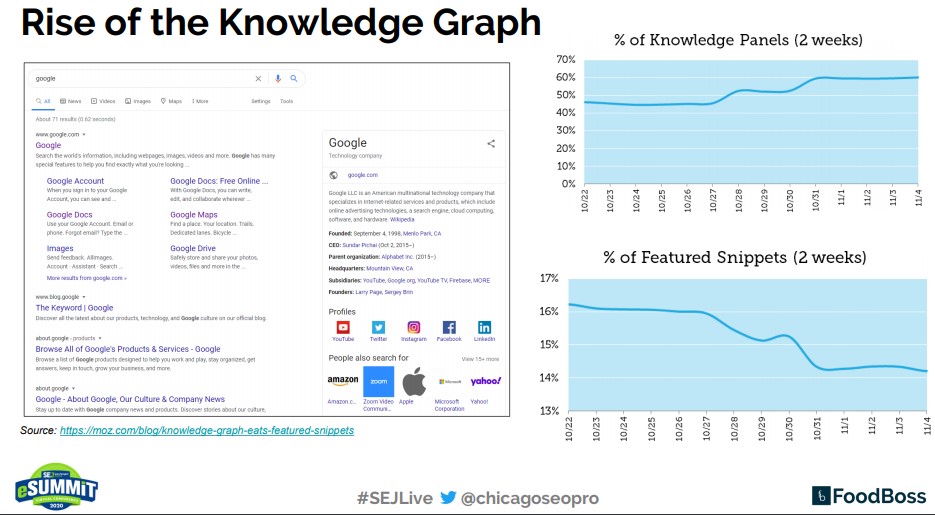11 Aug Structured Data & Relevance: Reading Between the Google Guidelines via @brentcsutoras
Structured data plays a big role in the future of search.
To future proof campaigns, SEO professionals should start paying more attention to Schema markup.
For her SEJ eSummit session, Jori Ford, Chief Marketing Officer at FoodBoss, discussed:
- The various types of structured data.
- How they are relevant to just about every algorithm update from 2015 to today.
- How they can fundamentally improve your search visibility and click-through rates.
Here’s a recap of her presentation.


“The more, you know, about the past, the better prepared you are for the future.” – Theodore Roosevelt
As SEO professionals and webmasters, we have to look to our past to better prepare ourselves for the future of organic search.
We’re like coaches.
In order to win, coaches have to look back at each game to evaluate how things have changed and what needs to be done to adapt.
That’s how great coaches build out plays that prepare the team for what lies ahead.
SEO professionals need to coach organizations on the understanding of search engine optimization and visibility.
We have to help:
- Engineers by coaching them on ways to implement and comply with best practices.
- Users, through their behaviors, to better understand what to expect coming from the search results to landing on websites.
Ultimately, to ensure the future of the businesses that we’re working with and for, we need to ask ourselves:
What do we need to understand about the past that we can establish and apply today?
Facts About Organic Search
First, let’s establish some facts about Google and organic search:
- Google needs data to provide results.
- Google wants us to make it easy to extract data from our sites.
- As Google advances, so does their demand for data.
- The need to make complex data easy to understand increases.
SEO professionals have to make sure that search engines understand how to interpret what our website is relevant to and how to convey that to users in a simplistic manner.
Digital marketers are tasked to make complicated concepts simple for everyone.
The Need for Structured Data
Google has been recommending the use of structured data on websites for a reason.
Adding markup to your content will help Google understand your page more clearly and get you more traffic – something that all SEO professionals want.


There are more reasons why we need to take structured data more seriously.
And to fully understand its importance, let’s take a look back at key algorithm updates in the past five years and how they are related in some ways to structured data.
Google Algorithm Updates: 2015 to Present
Since 2015, we’ve encountered several Google algorithm updates that significantly impacted search rankings.
- 2020: Core Updates and Featured Snippet De-Duplication.
- 2019: Core Updates, BERT, Diversity Update, E-A-T.
- 2018: Core Updates, Security, Mobile Speed, Video Carousels, Meta Descriptions, Zero Results SERP.
- 2017: Featured Snippet/Knowledge Graph Swap, Google Jobs.
- 2016: Core Updates, Random Tweaks, and Panda.
- 2015: RankBrain, Panda 4.2, Core Updates.


2015-2016: RankBrain
It was around this time when RankBrain started to reign supreme.
And for Google, it was a huge step forward.
RankBrain is an AI-based system Google began using in 2016 to understand how pages are related to concepts. It means we can better return relevant pages even if they don’t contain the exact words used in a search, by understanding the page is related to other words & concepts…
— Google SearchLiaison (@searchliaison) March 21, 2019
RankBrain was focused on one major thing – query matching.
Specifically, query matching based onrelational entity associations.
What’s the connection to structured data?
“Schema.org vocabulary can be used with many different encodings, including RDFa, Microdata and JSON-LD. These vocabularies cover entities, relationships between entities and actions…” – Schema.org
Simply put, structured data allows users (like us SEO professionals) to define entity relationships.
2017: Knowledge Graph
In 2017, we saw the rise of Knowledge Graphs in the SERPs.
But why does it matter?
This actually the first time we saw two features in the search results vying for attention.
They’re not just any two features.
Both of them are driven by structured data.
Around this time, we also started seeing more search results with influenced entities or elements into the mix.
Another feature introduced in 2017 was Job Listings in Search Results.


Google continues to introduce variance into the SERPs to answer questions, but the majority of these are driven by structured data.
It even encourages new markup use to see enriched or enhanced results for job searches.
2018: Video Carousels
Video carousels were rolled out into the SERPs in late 2017.
And even before Google officially announced and confirmed the new feature, GetStat already took notice and reported on the change.


Video carousels are also driven by structured data.
Google introduced this with the VideoObject schema.
It’s an opportunity to optimize your video clips, especially those not posted on YouTube, to be included into search results.
In desktop, you’ll see about three videos in a carousel.
But on mobile, there’s only one.
So if you’re not going to heavily invest in YouTube, you have to make sure that your video has structured data incorporated into it to show up in the results.
2019: BERT + Structured Data
BERT is probably the biggest Google algorithm update of 2019.
So many search experts tried to uncover and demystify BERT.
But if you think of it in the context of structured data, BERT was just the next step in evolving beyond RankBrain.
RankBrain was set on entity associations, but BERT was an expansion.
Google’s aim was to take disparate data sources that were all related – remember entity, relationships, and associations – and bring them together to make more robust results.
This is to make sure your questions are being answered, even if the search engine didn’t quite know what your question was about.
This was a big step in machine learning.


BERT actually learns via structured data.
Google provides a clear definition of what makes it unique.
It is considered as “the first deeply bidirectional, unsupervised language representation, pre-trained using only a plain text corpus.”
A text corpus is a large and structured set of texts.
E-A-T: Not an Algorithm Update, But Significant Enough to Mention
Structured data and E-A-T go hand in hand.
E-A-T was significant in 2019, and it continues to be significant in content interpretation today.
Lily Ray covered E-A-T thoroughly in her presentation, How to Improve Your Website’s E-A-T.
But what’s worth noting is the search quality raters guidelines call out ratings and reviews, specifically, as a way to determine the reputation of the creator of the content.


2020: Featured Snippet De-Duplication
In January 2020, Google rolled out a big change to featured snippets.
A webpage that’s already in the featured snippet position will no longer be repeated in regular Page 1 organic listings.
If a web page listing is elevated into the featured snippet position, we no longer repeat the listing in the search results. This declutters the results & helps users locate relevant information more easily. Featured snippets count as one of the ten web page listings we show.
— Danny Sullivan (@dannysullivan) January 22, 2020
What Does This All Mean for the Future?
No matter what year it is, we continue to see Google’s algorithms having a heavy reliance on structured data.
And you need to have structured data for full coverage today and beyond.


If you search for [covid] on Google, you’ll get a SERP that encompasses varied results – news stories, videos, tweets, and other real-time info.
But there’s one key thing to getting picked up.
It’s structured data.
You need it to dominate the search.
5 Steps to Securing Your SEO with Structured Data
Start securing and future-proofing your company’s SEO using structured data in five steps.
1. Understand Your Content Type
What type of content are you creating?
Your content is your key to getting markup right.
If you know what format you’re producing content in, that makes it easier to apply markup to and understand how Google will use or present your information in search results.
2. Structure Your Content
Organize it so that marking it up is simple.
Follow a hierarchical format on schema.org.
3. Review Organic Results
Look for structured data associations or popular formats that you can leverage for your own content.
4. Markup Everything
Use structured data everywhere, even in entities that are not yet being applied – if they are applicable to your content.
There are new entities being introduced regularly, as we’ve seen in the last five years.
So if you mark up everything, when something new gets introduced, you’re likely to be ahead of the current curve.
5. Be a First-Mover
Monitor changes to structured data pages using tools like Visualping or Distill.io.
Being a first-mover puts you ahead of the game.
Pro Tip: Focus on a Scalable Format
Google prefers JSON-LD as a structured data format.
It is the easiest to implement and makes nesting less complicated.
Google also uses this format for new markup.
JSON-LD can be injected using workers at the CDN level or using Google Tag Manager.
The only downfall is that some of the associations have to be present in order for Google to show them.
The Future Is Now
Majority of users are using mobile devices to access the web.
More people are using voice-enabled devices.
There are available structured data types to support mobile and voice searches.
Get ahead of the curve by using structured data for your content right now.
Watch this Presentation
You can now watch Ford’s full presentation from SEJ eSummit.
More Resources:


Sorry, the comment form is closed at this time.